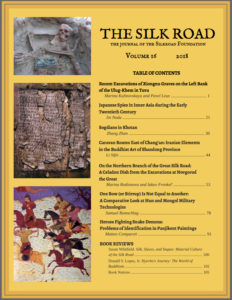It gives me great pleasure to introduce Volume 16 of The Silk Road. After more than fifteen years in the capable hands of longtime editor Daniel C. Waugh, The Silk Road baton has now passed into my hands. Much like parenthood, the responsibility of managing an annual journal is equal parts both blessing and burden, the latter marked by daily anxieties so consuming as to occasionally disrupt one’s evening slumber. Then come the minor triumphs that remind us why we got into this business in the first place: the production of fresh knowledge and dissemination of exciting new discoveries derived from the lands and peoples who continue to animate the historical rubric of the Silk Road.

The latest volume of The Silk Road fully lives up to this promise. Our excursion through place and time begins with a fascinating archaeological report by Marina Kulinovskaya and Pavel Leus on recently excavated Xiongnu graves in Tuva, lavishly illustrated with nearly fifty color photographs from the field. We are then treated to Jin Noda’s analysis of Japanese intelligence agents in Russian and Qing Inner Asia during the late nineteenth and early twentieth centuries. Next up is Zhang Zhan’s in-depth reassessment of ancient Sogdian documents from Khotan and what they can tell us about the status and occupations of these far-flung travelers during the first millennium CE. Zhang’s philological analysis is followed by Li Sifei’s investigation into the complex subject of Chinese perceptions of “Persians” and “Sogdians” during the Northern Zhou, Sui, and Tang dynasties. Marina Rodionova and Iakov Frenkel’ then encourage us to transfer our attention to the other, far less popularized end of the Silk Road, with a detailed case study of how a Mongol-era Chinese celadon made its way to the Novgorod Kremlin in Russia.
The Mongol backdrop plays an even more important role in Samuel Rumschlag’s sophisticated comparison of bow, saddle, and stirrup technology among different nomadic polities throughout Eurasian history. Finally, we have Matteo Compareti’s creative reading of the literary and artistic influences to be found in the painted programs of the great eastern Iranian hero Rustam in the Blue Hall at Panjikent. The issue concludes with reviews of two recent and important books by Susan Whitfield and Donald S. Lopez, Jr., along with detailed notices of other new books compiled—as generously and meticulously as before—by Daniel Waugh. In addition, our former editor has also contributed in innumerable other ways to the production of this volume, not least of which were his expert translations into English of the two articles originally co-authored in Russian.
In reflecting on the future of The Silk Road, I am reminded of a colophon added to the end of a Mahā-parinirvāna sutra from Dunhuang by former Gansu governor Chen Jikan in 1943. While lamenting how the voluminous manuscripts from the secret “cave library” of Dunhuang had now become “scarce and precious, like a phoenix or a blue moon,” Chen vowed to preserve the one remaining treasure that had fallen into his safekeeping. “I know that I cannot keep this manuscript forever,” he continued. “My only wish is to find someone to look after it, care for it, and not let this invaluable ancient ink be destroyed at the hands of anyone from my generation.” Chen was lucky: his Dunhuang manuscript eventually found its way to a museum in Shanghai, and is still read by scholars around the world more than a thousand years after its creation.
May The Silk Road be so fortunate.
– Justin M. Jacobs, Editor

